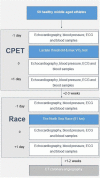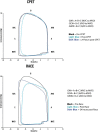Myocardial inefficiency is an early indicator of exercise-induced myocardial fatigue
- PMID: 36712275
- PMCID: PMC9874326
- DOI: 10.3389/fcvm.2022.1081664
Myocardial inefficiency is an early indicator of exercise-induced myocardial fatigue
Abstract
Background: The effect of prolonged, high-intensity endurance exercise on myocardial function is unclear. This study aimed to determine the left ventricular (LV) response to increased exercise duration and intensity using novel echocardiographic tools to assess myocardial work and fatigue.
Materials and methods: LV function was assessed by echocardiography before, immediately, and 24 h after a cardiopulmonary exercise test (CPET) and a 91-km mountain bike leisure race. Cardiac Troponin I (cTnI) was used to assess myocyte stress.
Results: 59 healthy recreational athletes, 52 (43-59) years of age, 73% males, were included. The race was longer and of higher intensity generating higher cTnI levels compared with the CPET (p < 0.0001): Race/CPET: exercise duration: 230 (210, 245)/43 (40, 45) minutes, mean heart rate: 154 ± 10/132 ± 12 bpm, max cTnI: 77 (37, 128)/12 (7, 23) ng/L. Stroke volume and cardiac output were higher after the race than CPET (p < 0.005). The two exercises did not differ in post-exercise changes in LV ejection fraction (LVEF) or global longitudinal strain (GLS). There was an increase in global wasted work (p = 0.001) following the race and a persistent reduction in global constructive work 24 h after exercise (p = 0.003).
Conclusion: Increased exercise intensity and duration were associated with increased myocardial wasted work post-exercise, without alterations in LVEF and GLS from baseline values. These findings suggest that markers of myocardial inefficiency may precede reduction in global LV function as markers of myocardial fatigue.
Keywords: athletes heart; exercise; exercise-induced cardiac fatigue; left ventricular function; myocardial efficiency; myocardial strain; myocardial work; sports cardiology.
Copyright © 2023 Erevik, Kleiven, Frøysa, Bjørkavoll-Bergseth, Chivulescu, Klæboe, Dejgaard, Auestad, Skadberg, Melberg, Urheim, Haugaa, Edvardsen and Ørn.
Conflict of interest statement
The authors declare that the research was conducted in the absence of any commercial or financial relationships that could be construed as a potential conflict of interest.
Figures



References
LinkOut - more resources
Full Text Sources
Research Materials
Miscellaneous

